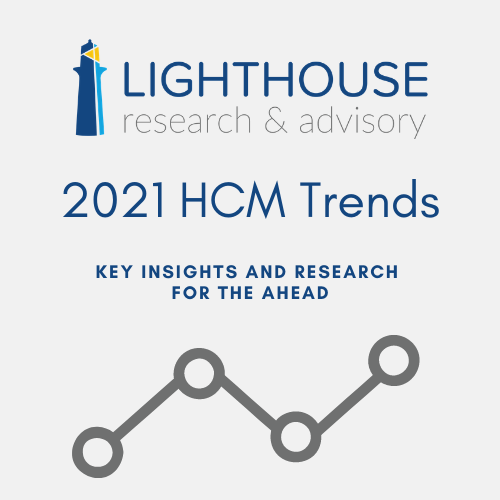7 HCM Trends for 2021: Prioritizing People-Centric HR
2020 is going to be the year that the world never forgets, but in a swirling pool of chaos there are some important components that we can’t miss. There are silver linings to every cloud, no matter how dark, and those present opportunities for employers to create better workplaces as time progresses.
Below are some key trends that every employer should consider, including looks at everything from talent to experience to equity and more. And, as is usual with our trends, these are based not just on our perspective but on the data, research, and evaluation of the technology landscape surrounding the employment ecosystem.

7 HCM Trends for 2021
1) Engagement is more than pay.
In the last 12 months, employees have ratcheted up their expectations for what they want from their employers. While there was a pandemic-induced spike in unemployment up to approximately 15%, that number has fallen continuously to 6.7%, a high the US hasn’t seen since 2013.
In the last year our research has shown that compensation itself needs to be more strategic in terms of planning and application, but there’s more to it than that. When a wide swath of the workforce was suddenly forced out of their workspace and into a kitchen, home office, or other remote work setup, employers had to rethink how they connect and engage with their people. If the only way that happens is via a paycheck, then the employees are going to start looking for a job elsewhere.
In spite of the remote nature of some industries (and unclear long-term prospects for returning to an office), business leaders must tackle this issue of engaging with people who they can’t see physically day to day. Whether that’s looking at a talent marketplace to provide low friction growth opportunities or thinking more seriously about wellbeing and mental health, there are ample opportunities to drive engagement (even if your CEO doesn’t care about engagement).
2) Hiring is about balancing automation and fairness.
Last year we highlighted a trend toward more fair and equitable hiring, but wild swings scaling hiring up and down in the last 12 months have emphasized the importance of automation like never before. When we consider that in addition to the fact that numerous automation tools for hiring have been consolidated under major brands in talent acquisition technology, it paints a clear picture that employers need to think not just about fair and equitable hiring, but also the importance of automation.
It may seem like a paradox: how do we create more human and fair hiring with technology? However, the tools that many employers are migrating to allow them to engage with every candidate with a single, unified experience. In addition, assessments for skills and other job-related aspects are being utilized more than ever to give employers a clear picture of candidate capabilities, minimizing bias. Site note: our research has shown that candidates actually don’t mind assessments, as long as they are related to the job and give them a chance to show off their best self.
It’s not enough to hire one or two diverse individuals as a temporary program. Equity must be woven into the fabric of hiring to ensure sustained positive outcomes for all candidates under consideration, both internal and external.
3) Rethinking the strategic value of payroll.
Employees trade time and/or results for money. While payroll as a process hasn’t changed, the capabilities of modern technology certainly have. Consider the following:
- About eight in 10 employees are living paycheck-to-paycheck, and a single $500 emergency could harm their financial future for years to come. Daily or on-demand pay allows workers to better manage their personal cash flow.
- The increase in virtual-first hiring due to the pandemic means more employers are willing to hire remotely, which could mean new state, locality, or even country-specific requirements.
- A reduction in the number of payroll-related jobs (27% reduction in new payroll jobs in 2020 versus 2019, according to economic data) due to smarter technology means those in the role must look for strategic ways to add value.
- Non-white employees are most likely to live in underbanked areas, forcing them to use expensive and costly options for basic financial transactions. Offering flexible pay, pay cards, and other tools can help to ensure a solid financial footing.
From financial wellness as a component of helping employees better manage their income to the diversity aspect of offering flexible pay options, there are many things to consider. To remain competitive, employers have to consider these changes and what they mean for the business. Payroll teams have a chance to step up and really shine with some of these different challenges.
4) Better insight into work and productivity.
Last year we highlighted the importance of looking not just at productivity from a traditional standpoint, but productivity in the proper areas that can’t be automated by technology. New academic research shows that many firms overemphasize generic innovation while undervaluing the importance of upstream thinking and maintaining the activities that produce value over time.
50 years ago, business leaders could see productivity data for many blue collar workers by looking at physical outputs from their labor. Today, there are new and emerging technologies that can show these kinds of insights for white collar workers, demonstrating their volume and depth of work in a way that wasn’t even possible before cloud-based work tools became the default.
Take the recent acquisition of work chatter tool Slack for instance. Salesforce has emerged as a player in the HR technology space with its Work.com launch, but having a tool like Slack in its wheelhouse will allow it to play more directly against Microsoft, whose analytics tools for O365 offer insights into worker productivity and more.
In 2021, we expect more employers to prioritize the analysis of insights into work and productivity to ensure their people are not only busy, but busy working on the things that really matter. We’ll be covering this concept on an upcoming episode of HR Tech Talks.
5) Skills are the currency of business.
Your team that manages corporate property can likely tell you the location, age, value after depreciation, and expected lifespan of one of your company-provided laptops.
Yet in most companies we have little to no centralized, verifiable data on the skills of the workforce. We know from our research that 81% of employers believe that they will need to reskill their people due to evolving technologies and automation.
In 1975, a full 83% of the value in the S&P 500 group of companies was in tangible assets:
- physical plants
- equipment
- property
In 2015, that number had dropped to just 16%, with the other 84% of value in intangible assets:
- intellectual property
- patents
- competencies/skills
The question I have is this: why we haven’t prioritized the identification, analysis, and development of skills with the urgency it demands?
In 2021, through the use of new tools and systems designed to accurately capture, measure, and report on employee skills, we will see employers truly operating on this new currency. This includes not just hard skills, but critical human skills as well. Additionally, with industry-wide collaborations to pull together blockchain-powered credential networks, this concept will see a widespread adoption like never before.
6) Equity beyond hiring.
For a long time diversity has been primarily centered around hiring, but forward-thinking employers are doing so much more. From ensuring that development and growth opportunities exist for all demographics to touching on fair pay and more, there are so many ways to put the lens of equity on the workplace.
For instance, Takeda Pharmaceuticals actually uses HR’s focus on equity to drive better business practices, such as more diverse representation during drug trials, supplier diversity, and more.
HR is the expert on talent within the business. If someone had a marketing challenge, they would talk to marketing. If they had an quality challenge, they would talk with the team responsible for quality. If they have a question about people, HR needs to step up.
Tackling inclusive hiring is now table stakes. It’s time to go deeper, leveraging diversity analytics and looking at how to enable better internal mobility practices, create opportunities for growth, and support the unique needs of different populations within the workforce.
7) Resilience for all.
If the last year has taught us anything, it’s that resilience—the ability to adapt and overcome change—is a critical skill in the workplace. Our research in 2020 also demonstrated the importance of resilience and adaptability at a company level, finding a clear link between business agility and the HR technology employers use.
On a more personal level, research shows that stress for many workers has never been higher, and the toll on mental health is high.
Prioritizing resilience at multiple levels will be critical for long-term success:
- Personal: can each person handle the changes coming their way? Are you providing resources to those who need additional help, especially in the midst of a chaotic pandemic?
- Team: can teams support each other and create the important aspect of psychological safety, which has been shown to indicate high performance among teams?
- Organization: does your organization have the tools, processes, and structure to adapt and overcome the disruptive forces that threaten your business, industry, or workforce?
Resilience has been a buzzword for quite some time. But now it’s time to commit. It’s time to elevate the conversation and make it happen. The tools and resources are there, but it’s up to us to give our people the access and support they need.
Interested in learning more about these trends or sharing your own perspectives? We’d love to hear from you.

Ben Eubanks is the Chief Research Officer at Lighthouse Research & Advisory. He is an author, speaker, and researcher with a passion for telling stories and making complex topics easy to understand.
His latest book Talent Scarcity answers the question every business leader has asked in recent years: “Where are all the people, and how do we get them back to work?” It shares practical and strategic recruiting and retention ideas and case studies for every employer.
His first book, Artificial Intelligence for HR, is the world’s most-cited resource on AI applications for hiring, development, and employee experience.
Ben has more than 10 years of experience both as an HR/recruiting executive as well as a researcher on workplace topics. His work is practical, relevant, and valued by practitioners from F100 firms to SMB organizations across the globe.
He has spoken to tens of thousands of HR professionals across the globe and enjoys sharing about technology, talent practices, and more. His speaking credits include the SHRM Annual Conference, Seminarium International, PeopleMatters Dubai and India, and over 100 other notable events.
